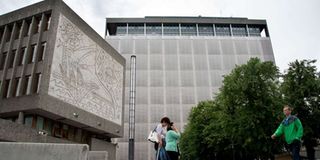Picasso murals removed from Oslo building damaged by Breivik

In this file photo taken on August 06, 2013 People pass Picasso's mural art work "The Fisherman" (L) on the government quarter's 'Y building' in Oslo, Norway on August 6, 2013. PHOTO| AFP
What you need to know:
- The "Y Block", a government building complex named for its shape, is scheduled to be demolished to make way for a new government complex buliding.
- The building suffered external damage from explosives that Breivik set before going on a shooting rampage, killing a combined 77 people.
Despite protests, the removal of two murals designed by Pablo Picasso began on Monday from an Oslo government building damaged in right-wing extremist Anders Behring Breivik's 2011 attack, a project manager said.
To be demolished
The "Y Block", a government building complex named for its shape, is scheduled to be demolished to make way for a new government complex buliding.
The building suffered external damage from explosives that Breivik set before going on a shooting rampage, killing a combined 77 people.
On its grey cement walls are two drawings by Picasso that were sandblasted by Norwegian artist Carl Nesjar, who collaborated with the Spanish master painter.
On the facade facing the street, "The Fishermen" depicts three men hauling their oversized catch onto their boat. In the lobby, "The Seagull" shows the bird, its wings spread wide, devouring a fish.
On Monday, the works, weighing 250 and 60 tonnes respectively, were enclosed in massive metal supports to be transported away and stored nearby, according to Statsbygg, the public agency in charge of overseeing the demolition.
"The operation is very slow" and should be completed by Thursday or Friday, site manager Pal Weiby told AFP.
The plan is to integrate the works into a new government building scheduled for completion in 2025.
Opponents of the project, both in Norway and abroad, have been mobilising in recent years to save the building, calling for it to be renovated and preserved as has been planned for its neighbour, "Block H".
"Block H" was home to the prime minister's offices until Breivik blew up a van loaded with 950 kilogrammes (2,100 pounds) of explosives at its base, before he went on to carry out a mass shooting on the island of Utoya.
Kjersti Hembre, an architect who was one of founders of the Save The Y-Block protests, told AFP that one of the main points of contention was that the decision was made without there ever being a serious investigation into whether it could be integrated in the new governmental quarter.
According to Hembre, the fact that the murals would be incorporated into the new structure demonstrated a "lack of understanding" of the works which not only adorne the building but are part of its load-bearing structure.
"It's a violation of the works that are integrated into the building architecture in an inseparable way" Hembre told AFP.





